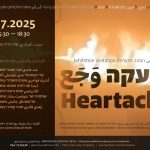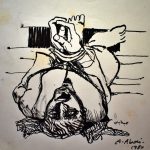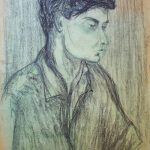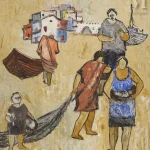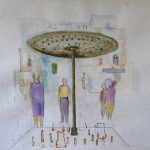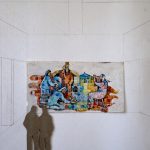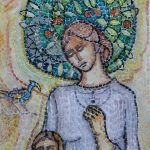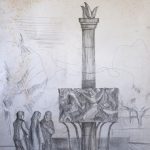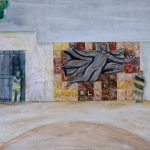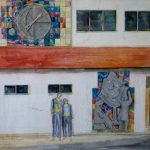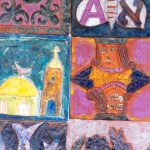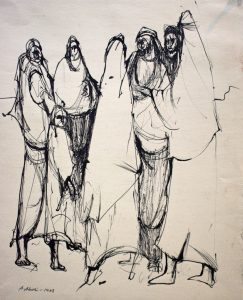
by ArtReview
I spent last week in Israel, my first-ever trip to that country, and I had intended to write this, and subsequent posts, for ArtReview while there. By the end of my first day, I quickly came to terms with the impossibility of such a task. Leaving one’s hotel each morning at nine and returning, on average, at two the following morning does not leave much time to write, at least for those of us who have come to realise that we tend towards the kind of prose that lies at the other end of the spectrum from ‘tweeting’.
The schedule’s pace was not my own doing, but that of the group that hosted me: Artis, a not-for-profit organisation dedicated to the promotion and exposure of the arts in Israel. This is a different way of wording the mission than one will find on Artis’s website, where the group is listed as one that ‘supports and promotes Israeli contemporary art throughout the world’.
national identity, and the land that subtends it, determines all of the region’s politics
That national adjective I find restrictive, at least at present, because it is more than evident, in speaking with the organisation’s committed and tireless staff, and from experiencing firsthand what they do and intend, that Artis is uniquely dedicated to supporting and promoting the art of a place and its peoples, rather than one that is limited to, and so determined by, the politics of national belonging (the latter is governed by heritage rather than the more statist, and to my mind preferable, concept of citizenship).
Needless to say, national identity, and the land that subtends it, determines all of the region’s politics. And more so than in Europe or America — much more so — there is nothing, no statement, no art, that is not political, no matter its intentions. Which is to say that the very fact that Artis is an ‘Israeli’ organisation places it on one side of the Arab–Israeli conflict. Like most arts organisations, one would describe its politics – or the politics of those who constitute and guide it — as liberal, if not left.
Within the Israeli context, this means a desire to see a Palestinian and Israeli state existing peacefully side by side. Yet politics is appearance, as the cliché goes, and for Artis this means that Arab and Palestinian artists, many educated in Israeli art schools and living and working in Israel, cannot see their way to being either supported or promoted by the group.
Though Artis is a private organisation which is completely independent of the state, appearing under the latter’s banner is often viewed by Palestinians and Arab artists as complicity with the state’s policies. The problem is not intractable. Artis is looking to help support artists such as Jumana Emil Abboud, Shadi Habib Allah, Emily Jacir and Sharif Waked; it facilitates introductions of non-Israeli artists, critics and curators to in-country groups, such as the Digital Arts Lab in Holon, and partners with media outlets, such as the newly launched Programma magazine, which are working towards creative forms of resolution and reconciliation; and they have even conducted arts professionals across the West Bank border for ‘unofficial’ visits to the International Academy of Art Palestine, in Ramallah.
For our own part, on our second day in Israel, Artis brought us to the Herzliya Museum of Contemporary Art, a brutalist architectural specimen (the kind that could make even Alison and Peter Smithson cringe) which is much larger and, as its programming indicates, more ambitious than any other essentially suburban museum I’ve ever visited (Herzliya, whose population numbers less than 90,000, is located just north of Tel Aviv and is included in the latter’s district).
In addition to an ongoing screening of Ai Weiwei’s Fairytale (2007), the artist’s film about bringing a thousand Chinese nationals to Documenta 12, and an installation of video, photography and sculpture related to Gregor Schneider’s ongoing Merzbau-esque Haus u r project (1985–), the museum had on display Men in the Sun, an exhibition of 13 Palestinian artists who live and work (or did live and work) in Israel.
The title of the show is taken from Ghassan Kanafani’s 1962 story about three Palestinian refugees trying to make their way to Kuwait in search of work. The journey across the desert is a difficult one, and crossing the Iraq-Kuwait border requires the help of a dishonest smuggler who persuades the men that he can get them through the checkpoints in the empty hold of his tanker truck. In the desert heat, the rusted tank is like an oven, but the smuggler promises the men they will only have to stay in it for a few minutes at each of the two stops.
The men barely survive their first session in the tank, and when, at the second checkpoint, their driver gets caught up in a conversation with the border guard, they die while silently awaiting release. For the curators of Men in the Sun, Tal Ben Zvi, an Israeli, and Hanna Farah-Kufer Bir’im, a Palestinian, Kanafani’s story crystallises the tragedy of both the real and psychological exile that the Palestinian people live on a daily basis, and it sets up the two ‘axes’ of the exhibition: the related alienations of silence and time.
Whether these interpretive axes made the work in the exhibition more or less legible is up for debate, but the very fact of the exhibition, which was mounted amidst a general boycott by Arab artists on exhibiting in Israeli art institutions, made it worth attending to. The work itself ranged from eerie expressionist drawings of the Palestinian diaspora dating to the late-1960s by Abed Abdi, to canonic late-1980s abstract paintings based on the sabra cactus by the late Asim Abu Shakra, to a selection of contemporary video pieces.
I’ll have more to say on video in Israel in a subsequent piece; suffice it here to note that the best art being made in the region is either straight-up or of a para-video character. Of the videos on view in Men in the Sun, exemplary was a work by Fahed Halabi, To You with Love (2009). At once comic, sad and disconcerting, the piece gives us the artist decked out like a construction worker — tank top, tool belt, cargo pants — belly dancing to a song by Lebanese pop diva Nancy Ajram. Watching the piece, and once the initial comic dissonance wears off, one begins to sense how its only the character’s obviously inner, sequestered life that is at all available to be indulged, and it slowly dawns that such is the case, duly generalised, for Palestinians as a whole.


